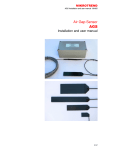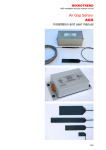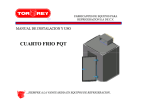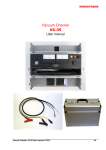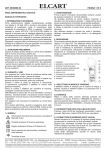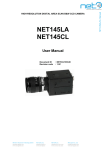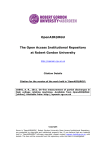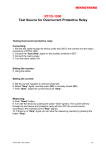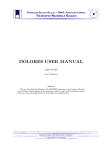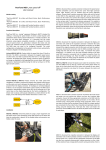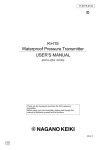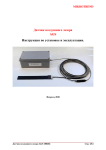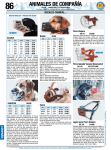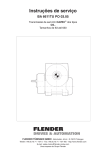Download Air Gap Sensor AGS
Transcript
MIKROTREND Air Gap Sensor AGS Installation and user manual Air Gap Sensor AGS - Installation and user manual 121126 1/15 MIKROTREND Contents 1. 2. 3. 4. Overview ................................................................................... 3 Application................................................................................ 4 Technical specifications ......................................................... 5 Instalation instructions ........................................................... 7 4.1. 4.2. 4.3. 4.4. 4.5. 4.6. 4.7. 4.8. 4.9. 4.10. 4.11. 4.12. 4.13. AGS Signal Conditioner unit installation guide................................. 7 Apropriate location for AGS Signal Conditioner unit ......................... 7 Grounding of AGS Signal Conditioner unit ....................................... 7 Power supply connection.................................................................. 7 Calibration......................................................................................... 7 AGS Sensor probe installation guide ................................................ 8 Placing the sensor ............................................................................ 8 Preparing the stator surface.............................................................. 9 Mounting the sensor ......................................................................... 9 True Air-Gap and offset ................................................................ 11 Cable installation .......................................................................... 12 Connection to Conditioner unit AGSC .......................................... 13 Typical measuring accuracy diagram ........................................... 14 5. Troubleshooting..................................................................... 14 6. Important notice ..................................................................... 15 Air Gap Sensor AGS - Installation and user manual 121126 2/15 MIKROTREND THIS INSTRUCTION MANUAL SHOULD BE READ CAREFULLY AND THE SAFETY INSTRUCTIONS OBSERVED BEFORE INSTALLING, CALIBRATING OR USING THE EQUIPMENT DESCRIBED HEREIN. - Installation and maintenance must be performed by qualified personnel familiar with the construction, operation, and hazards involved with the equipment. - Installation and maintenance must be performed with the control out of operation and disconnected from all sources of power - Care should be taken when servicing electrostatic sensitive components. The manufacturer’s recommendations for these components should be followed. - Ventilation passages should be kept open. - The means employed for grounding or insulating the equipment from ground should be checked to assure its integrity. - Care must be taken to avoid damaging any delicate components and to avoid displacing dust, dirt, or debris in a way that permits it to enter or settle into parts of the control equipment. - Enclosures should be inspected for evidence of deterioration. Accumulated dust and dirt should be removed from the top of the enclosures before opening doors or removing covers. 1. Overview High accuracy, non contact, capacitive type distance measuring transducer for measuring air-gap in air-cooled generators and electric motors Low profile sensor with triaxial cable, preamplifier and shielded cable High stability carbon particle semiconductive electrode DC/DC insulated power supply Optocoupler insulated output, 0…20 mA or 4...20mA Wide operating temperature range: -Sensor: 0...125°C, -Signal Conditioner: 0...55°C Immune to magnetic fields, dust and oil vapours, EMI, RFI Air Gap Sensor AGS - Installation and user manual 121126 3/15 MIKROTREND 2. Application Capacitive type Air Gap Sensor for air-cooled generators and electrical motors. It shall not be installed in hydrogen-cooled turbo-alternators. Linear measuring range: AGS-10: 2 to 10 mm AGS-15: 3 to 15 mm AGS-25: 5 to 25 mm AGS-50: 10 to 50 mm (other ranges available per request) High sensitivity, high resolution (up to 50 microns with oversampling). Measuring of air-gap, rotor vibrations, rotor symmetry, power angle… Figure 1: Image of Air Gap signal, zoom of two poles only Figure 2: Air Gap signal Air Gap Sensor AGS - Installation and user manual 121126 4/15 MIKROTREND Figure 3: Image of Air Gap signal, polar data 3. Technical specifications Probe dimensions Preamplifier cable Magnetic flux density Probe operating temperature Probe relative humidity Probe immunity Probe weight (with cable): Linear measuring range Measurement tolerance (typical) Linearity (typical) FSD Repeatability Output pole profile Sensitivity (0...20mA output) Sensitivity (0...10V output) Sensitivity (4...20mA output) Sensitivity (2...10V output) Typical frequency response: Power input Warm-up time Operating temperature Storage temperautre Relative humidity Vibration Shock Mech. dimensions Case protection class Weight AGS-10 93x32x1,2mm AGS-15 AGS-25 AGS-50 135x32x1,2mm 232x32x2,3mm 175x60x2,3mm 10m 12m +1,8 Tesla 0…125°C 95% non condensing magnetic fields, dust and oil vapours 330gr. 2...10mm 3...15mm 5...25mm 10...50mm +1% at 6mm +1% at 8mm +1,5% at 15mm +3% at 30mm <+1,5% <+3% <+5% <+1,5% <±0,3% 0…20mA, (0mA=0mm), or 4...20mA (4mA=0mm) with 500 Ohm termination resistor 0...10V (2...10V), opto-insulated 2mA/mm 1,33mA/mm 0,8mA/mm 0,4mA/mm 1V/mm 0,667V/mm 0,4V/mm 0,2V/mm 1,6mA/mm 1,067mA/mm 0,64mA/mm 0,32mA/mm 0,8V/mm 0,533V/mm 0,32V/mm 0,16V/mm 0...1000Hz, (-3dB) other bandwidth optional +24Vdc, ±10%, 0,15A max. 20...30 min. 0…55°C -20…85°C 95% non condensing IEC 68 2.27, 5 g peak, 10 Hz to 150 Hz IEC 68 2.27, 15 g peak, 11ms 220 × 120 × 80 mm w/o cable inlets IP66 AGS 350gr. AGSC 1500g Air Gap Sensor AGS - Installation and user manual 121126 5/15 MIKROTREND Figure 4: AGS-10 outline drawing Figure 5: AGS-15 outline drawing Figure 6: AGS-25 outline drawing Figure 7: AGS-50 outline drawing Air Gap Sensor AGS - Installation and user manual 121126 6/15 MIKROTREND 4. Instalation instructions 4.1. AGS Signal Conditioner unit installation guide Figure 8: The Conditioner unit AGSC 4.2. Apropriate location for AGS Signal Conditioner unit - up to 10 meters from the sensor probe, up to 100 meters from acquisition unit (with 0...20mA loop, if voltage output used interference free distance may vary), - prefer well ventilated, dry area free of vibrations and stray magnetic fields, - ensure adequate ground for enclosure with minimum lenght of wire, - ensure access to 24 Vdc Power Supply. Whenever possible use auxiliary enclosure with door end hinge to additionaly shield Conditioner unit from environmental influences, thermal changes etc. 4.3. Grounding of AGS Signal Conditioner unit CAUTION: Grounding is essential for system operation integrity as well as for protection against hazardous voltages. For best grounding, provide the shortest path possible between the Conditioner unit and the grounded structure. WARNING: MULTICORE CABLE SHIELD SHALL BE GROUNDED AT ACQUISITION CARD INPUT ONLY. MULTIPLE GROUND POINTS WILL CAUSE NOISE PICK-UP AND CAN DAMAGE CONDITIONER UNIT ELECTRONICS. 4.4. Power supply connection Power to AGS Signal Conditioner unit shall be 24VDC, ±10%, 0,15A max. Conditioner unit input has insulated DC-DC converter allowing any pole to be grounded or floating power supply as well as daisy chain of several Conditioner units. 4.5. Calibration The Sensor head and Signal Conditioner units are factory matched and calibrated for best performance. However if needed, can be calibrated at site. For details please cantact www.mikrotrend.com Air Gap Sensor AGS - Installation and user manual 121126 7/15 MIKROTREND 4.6. AGS Sensor probe installation guide CAUTION: The AGSsensor probe shall be handled with care. Do not apply paint or silicone to the sensor surface. Never pull or use excessive force on the sensor cable or preamplifier. The sensor surface is treated with high quality insulation varnish, it shall not be scrached as damage to semiconductive electrodes may occur. 4.7. Placing the sensor Choose position for Air Gap Sensor probe considering number of sensors and machine poles. True acurate stator geometry can be obtained with only two Rotor mounted Air Gap Sensors, also True acurate Rotor geometry can be obtained with only two Stator mounted Air Gap Sensors. (http://www.mikrotrend.com/wrm-wireless-hydrogenerator-rotor-monitor.htm) If Wireless Rotor AGS is not used than good practical results are achieved with: -4 sensors per generator for diameters of less than 7,5 meters, -8 sensors per generators with dimeter 7,5…12 meters -and 12 to 16 sensorsr for larger diameters. Place sensors on the upper side of the stator as it will have higher excentricity than the lower side. For stator height of more than 1,8 meters Air Gap sensors should be placed on the lower side also. Sensor shall be glued against stator laminations as deep as practical in the air gap. In general, this is beneath the second ventilation hole. The preamplifier (small black box integrated within the cable) must stay outside of the air gap and outside of the endwindings, if possible outside the stator casing. Figure 9: Air Gap Sensor positions Air Gap Sensor AGS - Installation and user manual 121126 8/15 MIKROTREND 4.8. Preparing the stator surface Thoroughly clean the stator surface, use allowed cleaning liquid such as isopropanol alcohol, disposable cotton rags and fine non metallic sandpaper. WARNING: DO NOT USE ACETONE OR OTHER SOLVENTS. Use a clean rag moistened with isopropanol over the stator surface to remove oil and carbon deposits. Epoxy coated or painted stator laminations check for mechanical stability. If necessary polish the surface and/or remove unstable particles with non metallic sandpaper. CAUTION: Sensor´s bottom surface shall be insulated from stator iron, (a thin coat of Epoxy adhesive will provide suficient insulation). After sanding, once again clean stator surface with a rag moistened with isopropanol. The glue surface should be flat, without protruding laminations, Slight unevenness can be tolerated (± 0.5mm). Let the isopropanol evaporate at room temperature for about one hour before proceeding with glue application. 4.9. Mounting the sensor The Air Gap Sensor probe must be aligned with the plane area of the rotor pole. The sensor measuring surface shall always be entirely covered by the pole surface. We recommend three metods for fastening the sensors, each with different curing times and operating temperatures: CAUTION: Commonly found Epoxid adhesive is not flexible enough. The sensor may come off due to uneven surface tensions during high load periods on generator. A. Double sided tape, (quick and easy): Double Side adhesive 3M Scotch Acrylic Foam Tape VHB 4611. With glue thickness of 1mm, a foam type tape will allow stator unevenness of up to 0,3 mm. Alowed temperatures of 149°C (for weeks) and short time up to 230°C (hours). Clean the back surface of the sensor with a cotton rag moistened with isopropanol. Place double sided adhesive tape on the back side of the sensor . Remove protective foil and carefully place sensor in position without touching adhesive surface. Using protective gloves or a rag press the sensor firmly against the stator surface. Adhesive is pressure sensitive and reacts on the first applied pressure. The sensor can be put in use imediatelly after gluing, full strenght will be reached after 24 hours. B. Silicone sealant-adhesive, non-acid (neutral), high temperature Our prefered mounting technique with high flexibility and high holding force. This is only metod recommended for Wireless Rotor AGS where high Gforces are present. Standard operation temperatures from 150°C up to 1200°C. A must for locations where stator surface coating has low adhesion to stator laminate. Silicone sealant effectively compensates uneven surface tensions during high load periods on generator thus ensuring stable mounting of the sensor. Air Gap Sensor AGS - Installation and user manual 121126 9/15 MIKROTREND With paper adhesive tape, mark border area about 5 mm larger on each side than sensor surface. Apply Silicone sealant about 1mm thick, evenly spread over entire back surface of the sensor. Carefuly place sensor within paper covered opening and firmly press until sealant stops comming out. Wipe of excess sealant with paper towel until clean and remove adhesive paper border. Fix the sensor in position with adhesive tape (Power-Tape) for at least 6 hours.Full curing times up to 24 h. shorter with higher ambient moisture. C: Two component glue (short curing time): If stator laminate coating is strong and stable and for continuous operation temperature not exceding 80°C, You can use two component adhesive type LOCTITE MULTIBOND 330. It is quick and simple application, but flexibility is not great and above mentioned precautions about surface stability and operating temperature shall be observed. When generator is under heavy load and if surface is not stable enough, the sensor may come off due to tensions which adhesive cannot compensate. Clean the back surface of the sensor with a rag moistened with alcohol. Follow manufacturers instructions. Curing times will vary with surface temperature, 50% of the final strength is reached after 10...30 minutes, full strength after approx. 5 hours. Figure 10: Air Gap Sensor probe installed at Stator pole Air Gap Sensor AGS - Installation and user manual 121126 10/15 MIKROTREND Figure 11: Air Gap Sensor installed at Rotor pole 4.10. True Air-Gap and offset The output of the signal conditioner provides the distance value between the sensor surface and rotor pole. Offset is the distance between the stator surface and sensor surface, including the thickness of the glue: Glue thickness+Sensor thickness vill vary with sensor type and mounting metod True Air-Gap is sum of measured and offset value. Offset compensation shall be made at the monitoring system. Figure 10: Offset distance Air Gap Sensor AGS - Installation and user manual 121126 11/15 MIKROTREND Figure 11: AGSC Adjustments NOTE: Before attempting new offset adjustement let AGSC Conditioner unit be powered for 20...30 minutes. Slowly turn trimmer potentiometer labeled Offset adj. untill reaching required output current/voltage. Normally, very small rotation will provide large changes on output. CAUTION: DO NOT adjust other trimmer potentiometers, (factory adjustment only). 4.11. Cable installation WARNING: BEWARE OF HIGH VOLTAGES ON THE STATOR BARS (5…22 KV). DO NOT ATTACH TRIAXIAL CABLE DIRECTLY TO THE STATOR BARS. THE TRIAXIAL CABLE, PREAMPLIFIER AND MULTICORE SHIELDED CABLE MUST BE PROTECTED BY A FLEXIBLE OR SEMI-RIGID POLYETHYLENE ( PVC ) CONDUIT. CAUTION: The triaxial cable shall not be modified. Muticore shielded cable (between Preamplifier and Conditioner unit ) may be shortened if neccesary. Gently preshape the triaxial cable by hand to get the right form, avoid to bend it beyond a right angle. Immobilize the triaxial cable inside The Air Gap to prevent vibrations and/or mechanical displacement: -hold the triaxial cable temporary with Cyanoacrylate type glue, point-glued to the stator laminations (iron) surface. -applly Silicone sealant along the cable in the Air Gap up to the exit making a strong permanent bond. Air Gap Sensor AGS - Installation and user manual 121126 12/15 MIKROTREND 4.12. Connection to Conditioner unit AGSC The figure illustrates how to connect the multicore cable to the Conditioner unit. Pole profile output gives instantaneous air-gap value measured by the sensor. It is optocoupled and insulated from sensor ground and also from power supply negative. Output signal can be ordered as 0...20mA or 4...20mA. NOTE: When 0...10V output is needed instead of 0...20mA (4...20mA), a current to voltage conversion resistor of 500 ohms should be placed at the end of line near the acquisition unit (lower noise level). Figure 12: AGS Wiring diagram Air Gap (mm) 0 2 10 Iout (mA) 0 4 20 Vout (V) at 500 Ohm 0 2 10 Table 1. AGS-10, 0...20mA, 2mA/mm, Output example Air Gap (mm) 0 2 10 Iout (mA) 4 7,2 20 Vout (V) at 500 Ohm 2 3,6 10 Table 2. AGS-10, 4...20mA, 1,6mA/mm, Output example Air Gap Sensor AGS - Installation and user manual 121126 13/15 MIKROTREND 4.13. Typical linearity diagram 11,00 error (%) 10,00 Vmeasured(V) 9,00 Vmeasured(V) Error(%) 8,00 7,00 6,00 5,00 4,00 3,00 2,00 1,00 0,00 -1,00 0 2 4 6 8 10 12 14 16 Air Gap (mm) 5. Troubleshooting Pole profile Output signal higher than 20mA or 10V: Check the distance to pole surface is within measuring range. If this happens during replacement of a new sensor slowly turn Offset adjustment trimmer potentiometer (inside Conditioner unit) until reaching desired output. 2. Pole profile Output signal to low: A. If this happens during replacement of a new sensor slowly turn Offset adjustment trimmer potentiometer inside Conditioner unit until reaching desired output. B. If this happens during normal working conditions check Sensor or Triax cable for damages. 3. 50 or 100Hz Noise in pole profile signal: A. Check grounding scheme. Ground loops shall be avoided. B. AGS Conditioner unit will tolerate aprox 0,1 Tesla of stray magnetic fields. If stronger fields are present use aditional protection box made from ferromagnetic material or move to other location. Air Gap Sensor AGS - Installation and user manual 121126 14/15 MIKROTREND 6. Important notice Mikrotrend d.o.o. and its subsidiaries reserve the right to make corrections, modifications, enhancements, improvements, and other changes to its products and services at any time and to discontinue any product or service without notice. Customers should obtain the latest relevant information before placing orders and should verify that such information is current and complete. All products are sold subject to Mikrotrend’s General terms and conditions of sale (http://www.mikrotrend.com/PDF/Selling Policy GT05c.pdf), supplied at the time of order acknowledgment. Mikrotrend warrants performance of its hardware products to the specifications applicable at the time of sale in accordance with Mikrotrend’s standard warranty. Testing and other quality control techniques are used to the extent Mikrotrend deems necessary to support this warranty. Except where mandated by government requirements, testing of all parameters of each product is not necessarily performed. Mikrotrend assumes no liability for applications assistance or customer product design. Customers are responsible for their products and applications using Mikrotrend components. To minimize the risks associated with customer products and applications, customers should provide adequate design and operating safeguards. Mikrotrend does not warrant or represent that any license, either express or implied, is granted under any Mikrotrend patent right, copyright, mask work right, or other Mikrotrend intellectual property right relating to any combination, machine, or process in which Mikrotrend products or services are used. Information published by Mikrotrend regarding third–party products or services does not constitute a license from Mikrotrend to use such products or services or a warranty or endorsement thereof. Use of such information may require a license from a third party under the patents or other intellectual property of the third party, or a license from Mikrotrend under the patents or other intellectual property of Mikrotrend. Reproduction of information in Mikrotrend data sheets is permissible only if reproduction is without alteration and is accompanied by all associated warranties, conditions, limitations, and notices. Reproduction of this information with alteration is an unfair and deceptive business practice. Mikrotrend is not responsible or liable for such altered documentation. Resale of Mikrotrend products or services with statements different from or beyond the parameters stated by Mikrotrend for that product or service voids all express and any implied warranties for the associated Mikrotrend product or service and is an unfair and deceptive business practice. Mikrotrend is not responsible or liable for any such statements. MIKROTREND d.o.o. Technology park Zagreb D.Golika 63, 10000 ZAGREB CROATIA, EUROPE Tel: +385 1 3667 114 Fax: +385 1 3667 115 GSM: +385 98 504 838 e-mail: [email protected] www.mikrotrend.com Air Gap Sensor AGS - Installation and user manual 121126 15/15















